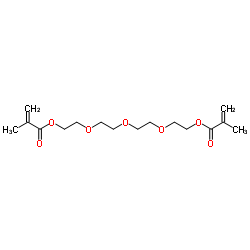Tetraethyleneglycol dimethacrylate

Tetraethyleneglycol dimethacrylate structure
|
Common Name | Tetraethyleneglycol dimethacrylate | ||
|---|---|---|---|---|
| CAS Number | 109-17-1 | Molecular Weight | 330.373 | |
| Density | 1.1±0.1 g/cm3 | Boiling Point | 409.2±30.0 °C at 760 mmHg | |
| Molecular Formula | C16H26O7 | Melting Point | N/A | |
| MSDS | Chinese USA | Flash Point | 176.4±24.6 °C | |
|
Polymeric nanocarriers for siRNA delivery to murine macrophages.
Macromol. Biosci. 14(8) , 1096-105, (2014) This work investigates the interactions of a polycationic nanocarrier with siRNA and with cells in order to better understand the capabilities and limitations of the carrier. The polycationic nanocarriers are cross-linked copolymer nanoparticles synthesized i... |
|
|
Construction of monomer-free, highly crosslinked, water-compatible polymers.
J. Dent. Res. 93(12) , 1326-31, (2014) Polymeric dental adhesives require the formation of densely crosslinked network structures to best ensure mechanical strength and durability in clinical service. Monomeric precursors to these materials typically consist of mixtures of hydrophilic and hydropho... |
|
|
Polymethacrylate monolithic columns for hydrophilic interaction liquid chromatography prepared using a secondary surface polymerization.
J. Chromatogr. A. 1402 , 82-93, (2015) Zwitterionic methacrylate based polymeric monolithic columns were prepared in two-step polymerizations, with reduced polymerization times. Characteristic properties such as hydrodynamic permeability, porosity, retention factors, and pore size distribution cha... |
|
|
Complexation Hydrogels as Oral Delivery Vehicles of Therapeutic Antibodies: An in Vitro and ex Vivo Evaluation of Antibody Stability and Bioactivity.
Ind. Eng. Chem. Res. 54 , 10197-10205, (2015) Oral administration of monoclonal antibodies (mAbs) may enable the localized treatment of infections or other conditions in the gastrointestinal tract (GI) as well as systemic diseases. As with the development of oral protein biotherapeutics, one of the most ... |
|
|
pH-responsive scaffolds generate a pro-healing response.
Biomaterials 57 , 22-32, (2015) A principal challenge in wound healing is a lack of cell recruitment, cell infiltration, and vascularization, which occurs in the absence of temporal and spatial cues. We hypothesized that a scaffold that expands due to local changes in pH may alter oxygen an... |
|
|
Prediction of the reduced glutathione (GSH) reactivity of dental methacrylate monomers using NMR spectra - Relationship between toxicity and GSH reactivity.
Dent. Mater. J. 28(6) , 722-9, (2009) It has been established that the toxicity of acrylate and methacrylate monomers is driven by their reactivity towards glutathione (GSH). With this relationship, the objective of this study was to predict the GSH reactivity of dental methacrylate monomers, and... |
|
|
Influence of the base and diluent monomer on network characteristics and mechanical properties of neat resin and composite materials.
Odontology 103 , 160-8, (2015) This study evaluated the effect of the combination of two dimethacrylate-based monomers [bisphenol A diglycidyl dimethacrylate (BisGMA) or bisphenol A ethoxylated dimethacrylate (BisEMA)] with diluents either derived from ethylene glycol dimethacrylate (ethyl... |
|
|
Fracture toughness of water-aged resin composite restorative materials.
Dent. Mater. 11(3) , 201-7, (1995) The purpose of this study was to assess the effects of aging experimental dimethacrylate resin composites in water at 37 degrees C for periods up to 6 wk by measuring the variations in fracture toughness (K(c)), elastic modulus (E), fracture energy (G(c)), an... |
|
|
Oral insulin delivery using P(MAA-g-EG) hydrogels: effects of network morphology on insulin delivery characteristics.
J. Control. Release 95(3) , 589-99, (2004) Hydrogels of poly(methacrylic acid-g-ethylene glycol) were prepared using different reaction water contents in order to vary the network mesh size, swelling behavior and insulin loading/release kinetics. Gels prepared with greater reaction solvent contents sw... |
|
|
Effect of photoinitiator level on properties of a light-cured and post-cure heated model resin system.
Dent. Mater. 13(6) , 360-4, (1997) This study evaluated the effect of increased levels of photoinitiator components on biaxial flexural strength, monomer conversion, and dynamic thermal properties of an unfilled model resin system in both the light-cured only state as well as after post-cure h... |